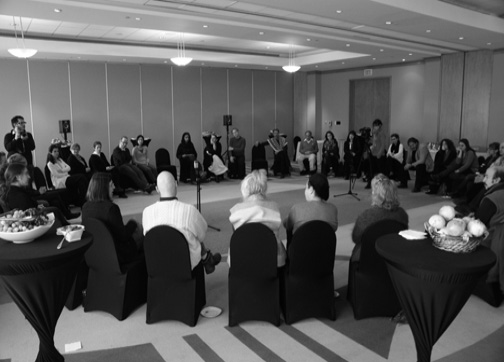
THE JEWISH HOME BEAUTIFUL - REVISITED II
first performed on
January 23, 2011
Gelber Conference Centre, Montreal, Canada
performed once in 2011
DEVORA NEUMARK
in collaboration with Chantale Laplante, Sonia Zylberberg, Diana Yaros
THE JEWISH HOME BEAUTIFUL - REVISITED II
DEVORA NEUMARK
At the heart of this dialogic live art event-which was scheduled to coincide with the holiday of Tu Bishvat, the Jewish annual celebration of Arbor Day-was a critical reflection about our physical and symbolic relationship to the orchards, groves and forests that sustain life. While we celebrated the New Year for Trees and marked the Middle Eastern season wherein the earliest blossoms emerge from their winter sleep to begin a new fruit-bearing cycle, we also considered the choices about which trees are being planted and which are being cut down (and by whom) in Israel/Palestine.
As a Jewish artist-scholar reflecting on the forces that have shaped my life experience and relationship to culture-including the legacy of multiple forced dislocations-I have been exploring the ambivalent role of beauty in the (un)making of home; how the affirmation of beauty and settling at home of one population can have a devastating impact on another. “The Jewish Home Beautiful-Revisited II,” like the first “Jewish Home Beautiful-Revisited” (which took place on June 2, 2010 in Concordia University’s FOFA Gallery) is part of a series of performance art events entitled “Radical Beauty for Troubled Times” and was based in part on the Jewish Home Beautiful community pageant written in the 1930s by Betty Greenberg and Althea Silverman. Unlike the original theatrical scripted event, this co-creative series invites a sensory-laden and affectively charged participatory exploration of how beauty, while vital in sustaining communities, can also be used to perpetuate fixed identity reflexes stemming from the need to survive displacement.
In addition to serving some traditional foods associated with Tu Bishvat, my collaborators and I created an audio environment with pre-recorded sound and live music involving, amongst other things, the sounds of trees being uprooted and a recitation of the October 2010 Yesh Din report on 97 separate incidents of vandalization of Palestinians’ trees in the Occupied Territories. As we ate the fruit of these trees and listened to the soundscape, the dialogue opened to include critical reflections about individual and collective responsibility for Canadian policy on the Middle East, personal narratives related to the loss of home, poetic offerings evoking gratitude for the food shared, and ideas about how to support Palestinian farmers in their struggle to keep their crops and trees safe from Israeli settlers intent on destroying their ties to the land and their livelihood.